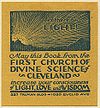The International Divine Science Association was founded in 1892 in San Francisco, California by religious leader and author Malinda Cramer.[1] The association was "founded for the promulgation of Divine Science, the God idea of perfect unity, harmony and wholeness, associated together in a unity of spirit, for the healing of nations, and the general good of humanity."[2]
The International Divine Science Association hosted several New Thought Congresses through the 1890s. The association was a loose coalition of Divine Science leaders and centers across the United States,[3] and is credited as the first of several umbrella organizations created at the turn of the 20th century for the New Thought movement.[4]
Bibliography[edit]
- Satter, B. (2001) Each Mind a Kingdom: American Women, Sexual Purity, and the New Thought Movement, 1875–1920. University of California Press. p 106–110.
References[edit]
- ^ Hill Lindley, S. and Stebner, E.J. (2008) The Westminster handbook to women in American religious history. Westminster John Knox Press. p 49.
- ^ Horatio Willis Dresser. (1919) A history of the new thought movement. T. Y. Crowell Company. p 193-196.
- ^ Melton, J.R. and Baumann, M. (2002) Religions of the world: A comprehensive encyclopedia of beliefs and practices. D - J, Volume 2. ABC-CLIO. p 400.
- ^ Melton, J.R. (1999) Religious leaders of America: A biographical guide to founders and leaders of religious bodies, churches, and spiritual groups in North America. Gale Research. p 138.

Well, that’s interesting to know that Psilotum nudum are known as whisk ferns. Psilotum nudum is the commoner species of the two. While the P. flaccidum is a rare species and is found in the tropical islands. Both the species are usually epiphytic in habit and grow upon tree ferns. These species may also be terrestrial and grow in humus or in the crevices of the rocks.
View the detailed Guide of Psilotum nudum: Detailed Study Of Psilotum Nudum (Whisk Fern), Classification, Anatomy, Reproduction